think否定转移的用法分析(一)
- 格式:docx
- 大小:20.70 KB
- 文档页数:2

否定转移的用法公司内部编号:(GOOD-TMMT-MMUT-UUPTY-UUYY-DTTI-否定转移的用法1) 将think, believe, suppose, expect, fancy, imagine等动词后面宾语从句的否定词转移到主句中,即主句的谓语动词用否定式,而从句的谓语动词用肯定式。
I don”t think I know you. 我想我并不认识你。
I don” t believe he will come. 我相信他不回来。
注意:若谓语动词为hope,宾语从句中的否定词不能转移。
I hope you weren”t ill. 我想你没有生病吧。
2) 将seem, appear 等后的从句的否定转移到前面。
It doesn”t seem that they know where to go.看来他们不知道往哪去。
It doesn”t appear that we”ll have a sunny day tomorrow.看来我们明天不会碰上好天气。
3) 有时将动名词,介词短语或整个从句的否定转变为对谓语动词的否定。
I don”t remember having ever seen such a man.我记得从未见过这样一个人。
(not否定动名词短语 having…)It”s not a place where anyone would expect to see strange characters on the street.在这里,人们不会想到在街上会碰上陌生的人。
(anyone 作主语,从句中的谓语动词不能用否定形式。
)否定转移用法总结kenny128 (2006-03-11 12:52)有感于课文中一句话的理解)山东高唐一中刘长友外研版的新课标英语课本第二册Module 1 “Zhou Kai(2)p2中有这样一句话:I think I don’t get these things because I take a lot of exercise and am very fit.不少有学有基础的学生,其中包括一些老师,对这一个句子中,该不该用否定转移的句子,展开了激烈讨论。
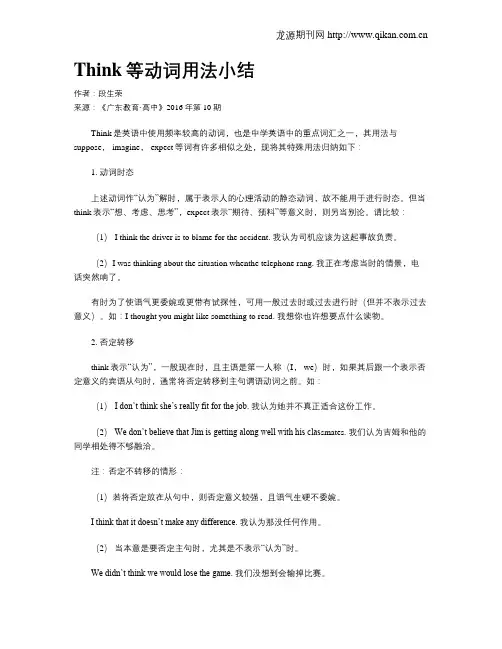
Think等动词用法小结作者:段生荣来源:《广东教育·高中》2016年第10期Think是英语中使用频率较高的动词,也是中学英语中的重点词汇之一,其用法与suppose, imagine, expect等词有许多相似之处,现将其特殊用法归纳如下:1. 动词时态上述动词作“认为”解时,属于表示人的心理活动的静态动词,故不能用于进行时态。
但当think表示“想、考虑、思考”,expect表示“期待、预料”等意义时,则另当别论。
请比较:(1) I think the driver is to blame for the accident. 我认为司机应该为这起事故负责。
(2)I was thinking about the situation whenthe telephone rang. 我正在考虑当时的情景,电话突然响了。
有时为了使语气更委婉或更带有试探性,可用一般过去时或过去进行时(但并不表示过去意义)。
如:I thought you might like something to read. 我想你也许想要点什么读物。
2. 否定转移think表示“认为”,一般现在时,且主语是第一人称(I, we)时,如果其后跟一个表示否定意义的宾语从句时,通常将否定转移到主句谓语动词之前。
如:(1)I don’t think she’s really fit for the job. 我认为她并不真正适合这份工作。
(2)We don’t believe that Jim is getting along well with his clas smates. 我们认为吉姆和他的同学相处得不够融洽。
注:否定不转移的情形:(1)若将否定放在从句中,则否定意义较强,且语气生硬不委婉。
I think that it doesn’t make any difference. 我认为那没任何作用。
(2)当本意是要否定主句时,尤其是不表示“认为”时。
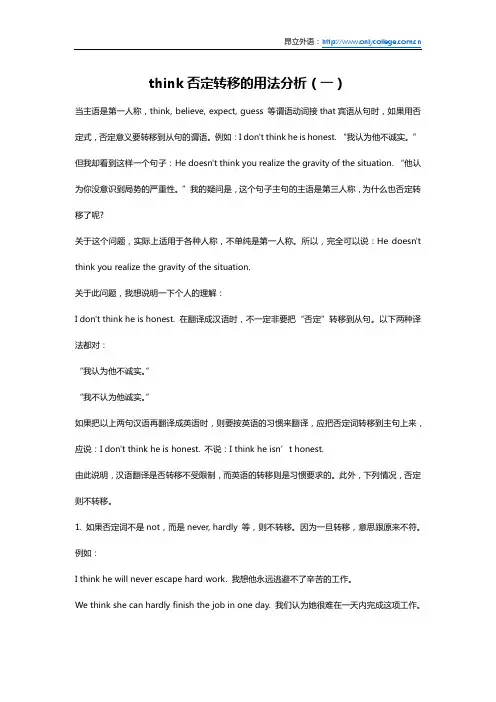
think否定转移的用法分析(一)当主语是第一人称,think, believe, expect, guess 等谓语动词接that宾语从句时,如果用否定式,否定意义要转移到从句的谓语。
例如:I don't think he is honest. “我认为他不诚实。
”但我却看到这样一个句子:He doesn't think you realize the gravity of the situation. “他认为你没意识到局势的严重性。
”我的疑问是,这个句子主句的主语是第三人称,为什么也否定转移了呢?关于这个问题,实际上适用于各种人称,不单纯是第一人称。
所以,完全可以说:He doesn't think you realize the gravity of the situation.关于此问题,我想说明一下个人的理解:I don't think he is honest. 在翻译成汉语时,不一定非要把“否定”转移到从句。
以下两种译法都对:“我认为他不诚实。
”“我不认为他诚实。
”如果把以上两句汉语再翻译成英语时,则要按英语的习惯来翻译,应把否定词转移到主句上来,应说:I don't think he is honest. 不说:I think he isn’t honest.由此说明,汉语翻译是否转移不受限制,而英语的转移则是习惯要求的。
此外,下列情况,否定则不转移。
1. 如果否定词不是not,而是never, hardly 等,则不转移。
因为一旦转移,意思跟原来不符。
例如:I think he will never escape hard work. 我想他永远逃避不了辛苦的工作。
We think she can hardly finish the job in one day. 我们认为她很难在一天内完成这项工作。
2. 如果think有其他成分修饰,则不转移。
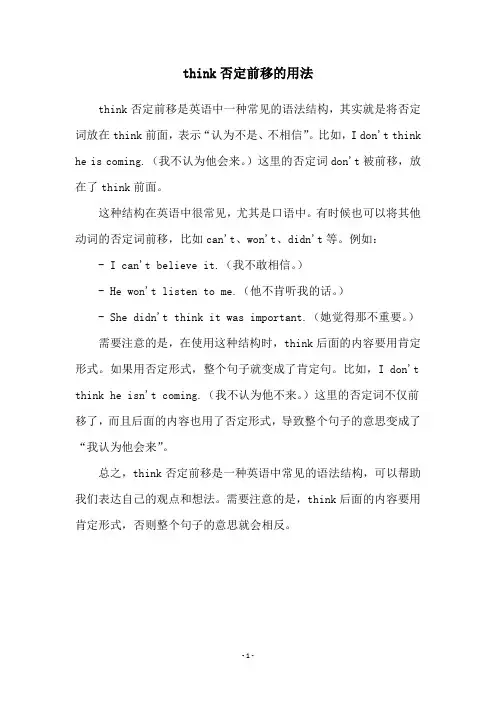
think否定前移的用法
think否定前移是英语中一种常见的语法结构,其实就是将否定词放在think前面,表示“认为不是、不相信”。
比如,I don't think he is coming.(我不认为他会来。
)这里的否定词don't被前移,放在了think前面。
这种结构在英语中很常见,尤其是口语中。
有时候也可以将其他动词的否定词前移,比如can't、won't、didn't等。
例如:
- I can't believe it.(我不敢相信。
)
- He won't listen to me.(他不肯听我的话。
)
- She didn't think it was important.(她觉得那不重要。
)需要注意的是,在使用这种结构时,think后面的内容要用肯定形式。
如果用否定形式,整个句子就变成了肯定句。
比如,I don't think he isn't coming.(我不认为他不来。
)这里的否定词不仅前移了,而且后面的内容也用了否定形式,导致整个句子的意思变成了“我认为他会来”。
总之,think否定前移是一种英语中常见的语法结构,可以帮助我们表达自己的观点和想法。
需要注意的是,think后面的内容要用肯定形式,否则整个句子的意思就会相反。
- 1 -。
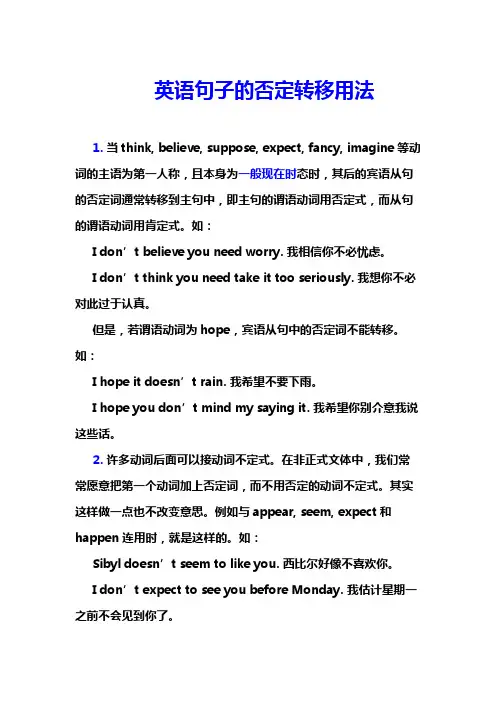
英语句子的否定转移用法1.当think, believe, suppose, expect, fancy, imagine等动词的主语为第一人称,且本身为一般现在时态时,其后的宾语从句的否定词通常转移到主句中,即主句的谓语动词用否定式,而从句的谓语动词用肯定式。
如:I don’t believe you need worry.我相信你不必忧虑。
I don’t think you need take it too seriously. 我想你不必对此过于认真。
但是,若谓语动词为hope,宾语从句中的否定词不能转移。
如:I hope it doesn’t rain.我希望不要下雨。
I hope you don’t mind my saying it.我希望你别介意我说这些话。
2.许多动词后面可以接动词不定式。
在非正式文体中,我们常常愿意把第一个动词加上否定词,而不用否定的动词不定式。
其实这样做一点也不改变意思。
例如与appear, seem, expect和happen连用时,就是这样的。
如:Sibyl doesn’t seem to like you.西比尔好像不喜欢你。
I don’t expect to see you before Monday.我估计星期一之前不会见到你了。
It does not seem that the man understand what I am saying. 那男人似乎不了解我在说什么。
与“intend / want+动词不定式”连用时,我们几乎总是将not / never与第一个动词放在一起。
如:I don’t want to fail this exam.这次考试我不想考不及格。
After I’ve finished this contract I never intend to teach again. 这个合同期满后,我决不想再教书了。
请注意can’t seem to…这一结构。
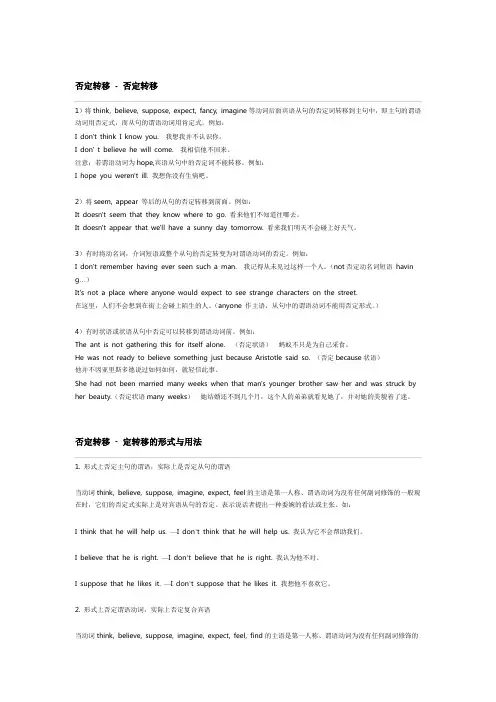
否定转移- 否定转移1)将think, believe, suppose, expect, fancy, imagine等动词后面宾语从句的否定词转移到主句中,即主句的谓语动词用否定式,而从句的谓语动词用肯定式。
例如:I don't think I know you.我想我并不认识你。
I don' t believe he will come.我相信他不回来。
注意:若谓语动词为hope,宾语从句中的否定词不能转移。
例如:I hope you weren't ill. 我想你没有生病吧。
2)将seem, appear 等后的从句的否定转移到前面。
例如:It doesn't seem that they know where to go. 看来他们不知道往哪去。
It doesn't appear that we'll have a sunny day tomorrow. 看来我们明天不会碰上好天气。
3)有时将动名词,介词短语或整个从句的否定转变为对谓语动词的否定。
例如:I don't remember having ever seen such a man.我记得从未见过这样一个人。
(not否定动名词短语havin g…)It's not a place where anyone would expect to see strange characters on the street.在这里,人们不会想到在街上会碰上陌生的人。
(anyone 作主语,从句中的谓语动词不能用否定形式。
)4)有时状语或状语从句中否定可以转移到谓语动词前。
例如:The ant is not gathering this for itself alone.(否定状语)蚂蚁不只是为自己采食。
He was not ready to believe something just because Aristotle said so. (否定because状语)他并不因亚里斯多德说过如何如何,就轻信此事。
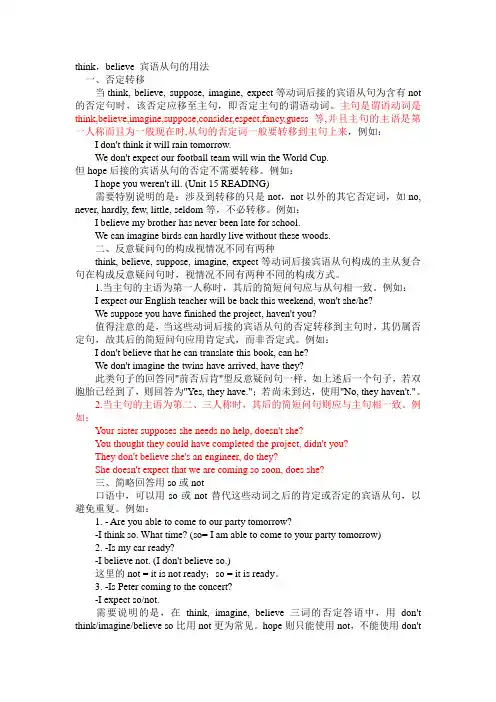
think,believe 宾语从句的用法一、否定转移当think, believe, suppose, imagine, expect等动词后接的宾语从句为含有not 的否定句时,该否定应移至主句,即否定主句的谓语动词。
主句是谓语动词是think,believe,imagine,suppose,consider,espect,fancy,guess等,并且主句的主语是第一人称而且为一般现在时,从句的否定词一般要转移到主句上来,例如:I don't think it will rain tomorrow.We don't expect our football team will win the World Cup.但hope后接的宾语从句的否定不需要转移。
例如:I hope you weren't ill. (Unit 15 READING)需要特别说明的是:涉及到转移的只是not,not以外的其它否定词,如no, never, hardly, few, little, seldom等,不必转移。
例如:I believe my brother has never been late for school.We can imagine birds can hardly live without these woods.二、反意疑问句的构成视情况不同有两种think, believe, suppose, imagine, expect等动词后接宾语从句构成的主从复合句在构成反意疑问句时,视情况不同有两种不同的构成方式。
1.当主句的主语为第一人称时,其后的简短问句应与从句相一致。
例如:I expect our English teacher will be back this weekend, won't she/he?We suppose you have finished the project, haven't you?值得注意的是,当这些动词后接的宾语从句的否定转移到主句时,其仍属否定句,故其后的简短问句应用肯定式,而非否定式。
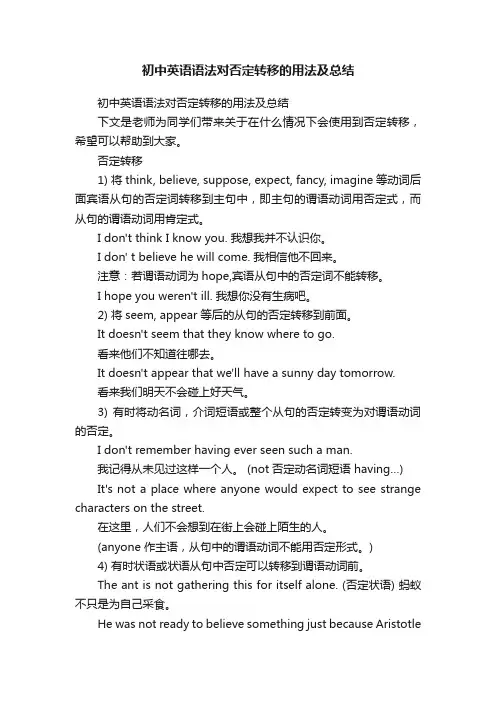
初中英语语法对否定转移的用法及总结初中英语语法对否定转移的用法及总结下文是老师为同学们带来关于在什么情况下会使用到否定转移,希望可以帮助到大家。
否定转移1) 将think, believe, suppose, expect, fancy, imagine等动词后面宾语从句的否定词转移到主句中,即主句的谓语动词用否定式,而从句的谓语动词用肯定式。
I don't think I know you. 我想我并不认识你。
I don' t believe he will come. 我相信他不回来。
注意:若谓语动词为hope,宾语从句中的否定词不能转移。
I hope you weren't ill. 我想你没有生病吧。
2) 将seem, appear 等后的从句的否定转移到前面。
It doesn't seem that they know where to go.看来他们不知道往哪去。
It doesn't appear that we'll have a sunny day tomorrow.看来我们明天不会碰上好天气。
3) 有时将动名词,介词短语或整个从句的否定转变为对谓语动词的否定。
I don't remember having ever seen such a man.我记得从未见过这样一个人。
(not否定动名词短语having…)It's not a place where anyone would expect to see strange characters on the street.在这里,人们不会想到在街上会碰上陌生的人。
(anyone 作主语,从句中的谓语动词不能用否定形式。
)4) 有时状语或状语从句中否定可以转移到谓语动词前。
The ant is not gathering this for itself alone. (否定状语) 蚂蚁不只是为自己采食。
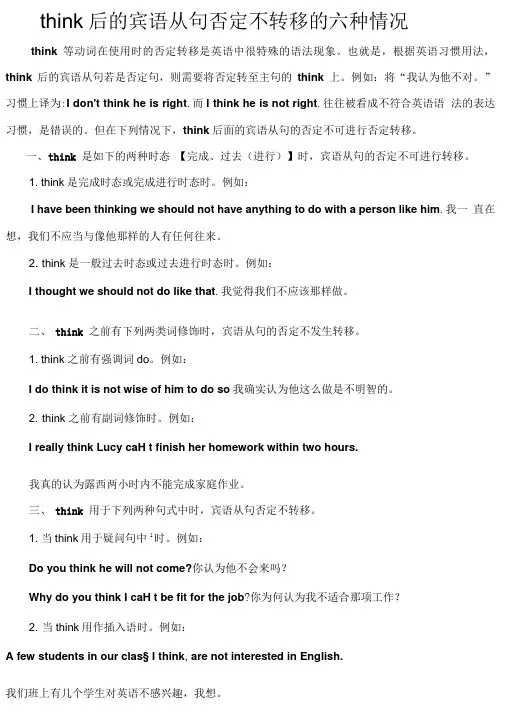
think后的宾语从句否定不转移的六种情况think等动词在使用时的否定转移是英语中很特殊的语法现象。
也就是,根据英语习惯用法,think后的宾语从句若是否定句,则需要将否定转至主句的think上。
例如:将“我认为他不对。
” 习惯上译为:I don't think he is right.而I think he is not right.往往被看成不符合英语语法的表达习惯,是错误的。
但在下列情况下,think后面的宾语从句的否定不可进行否定转移。
一、think 是如下的两种时态【完成、过去(进行)】时,宾语从句的否定不可进行转移。
1. think是完成时态或完成进行时态时。
例如:I have been thinking we should not have anything to do with a person like him.我一直在想,我们不应当与像他那样的人有任何往来。
2. think 是一般过去时态或过去进行时态时。
例如:I thought we should not do like that.我觉得我们不应该那样做。
二、think 之前有下列两类词修饰时,宾语从句的否定不发生转移。
1. think 之前有强调词do。
例如:I do think it is not wise of him to do so我确实认为他这么做是不明智的。
2. think 之前有副词修饰时。
例如:I really think Lucy caH t finish her homework within two hours.我真的认为露西两小时内不能完成家庭作业。
三、think 用于下列两种句式中时,宾语从句否定不转移。
1. 当think用于疑问句中1时。
例如:Do you think he will not come?你认为他不会来吗?Why do you think I caH t be fit for the job?你为何认为我不适合那项工作?2. 当think用作插入语时。
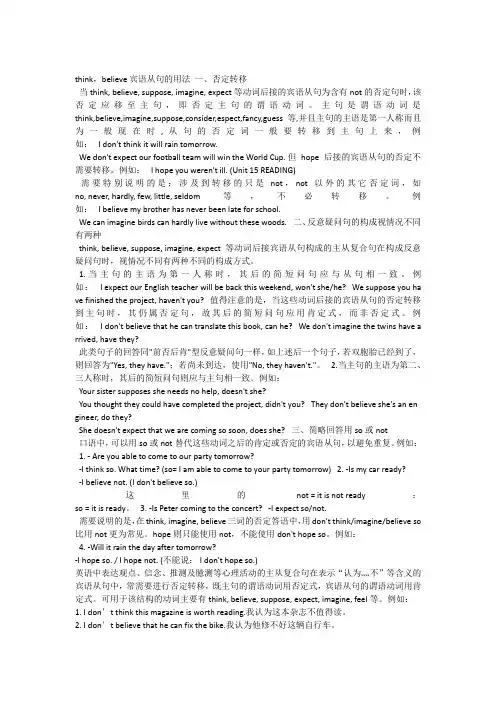
think,believe 宾语从句的用法一、否定转移当think, believe, suppose, imagine, expect等动词后接的宾语从句为含有not的否定句时,该否定应移至主句,即否定主句的谓语动词。
主句是谓语动词是think,believe,imagine,suppose,consider,espect,fancy,guess等,并且主句的主语是第一人称而且为一般现在时,从句的否定词一般要转移到主句上来,例如: I don't think it will rain tomorrow.We don't expect our football team will win the World Cup. 但hope后接的宾语从句的否定不需要转移。
例如: I hope you weren't ill. (Unit 15 READING)需要特别说明的是:涉及到转移的只是not,not以外的其它否定词,如no, never, hardly, few, little, seldom等,不必转移。
例如: I believe my brother has never been late for school.We can imagine birds can hardly live without these woods. 二、反意疑问句的构成视情况不同有两种think, believe, suppose, imagine, expect等动词后接宾语从句构成的主从复合句在构成反意疑问句时,视情况不同有两种不同的构成方式。
1.当主句的主语为第一人称时,其后的简短问句应与从句相一致。
例如: I expect our English teacher will be back this weekend, won't she/he? We suppose you ha ve finished the project, haven't you? 值得注意的是,当这些动词后接的宾语从句的否定转移到主句时,其仍属否定句,故其后的简短问句应用肯定式,而非否定式。
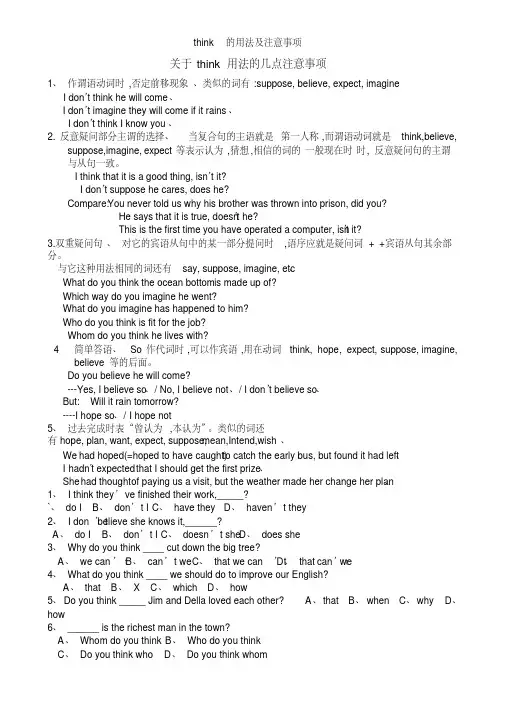
关于think用法的几点注意事项1、作谓语动词时,否定前移现象、类似的词有:suppose, believe, expect, imagineI don’t think he will come、I don’t imagine they will come if it rains、I don’t think I know you、2. 反意疑问部分主谓的选择、当复合句的主语就是第一人称,而谓语动词就是think,believe,suppose,imagine, expect等表示认为,猜想,相信的词的一般现在时时, 反意疑问句的主谓与从句一致。
I think that it is a good thing, isn’t it?I don’t suppose he cares, does he?Compare:You never told us why his brother was thrown into prison, did you?He says that it is true, doesn’t he?This is the first time you have operated a computer, isn’t it?3.双重疑问句、对它的宾语从句中的某一部分提问时,语序应就是疑问词+ +宾语从句其余部分。
与它这种用法相同的词还有say, suppose, imagine, etc、What do you think the ocean bottom i s made up of?Which way do you imagine he went?What do you imagine has happened to him?Who do you think is fit for the job?Whom do you think he lives with?4简单答语、So 作代词时,可以作宾语,用在动词think, hope, expect, suppose, imagine, believe 等的后面。
英语中否定转移的形式与用法一、动词的否定转移1. 形式上否定主句的谓语,实际上是否定从句的谓语当动词think, believe, suppose, imagine, expect, feel 的主语是第一人称、谓语动词为没有任何副词修饰的一般现在时,它们的否定式实际上是对宾语从句的否定。
表示说话者提出一种委婉的看法或主张。
如:I think that he will help us. —I don't think that he will help us. 我认为它不会帮助我们。
I believe that he is right. —I don't believe that he is right. 我认为他不对。
I suppose that he likes it. —I don't suppose that he likes it. 我想他不喜欢它。
2. 形式上否定谓语动词,实际上否定复合宾语当动词think, believe, suppose, imagine, expect, feel, find的主语是第一人称、谓语动词为没有任何副词修饰的一般现在时,它们前面的否定式实际上是对复合宾语的否定。
表示说话者所提出的一种委婉的看法或主张。
如:I think math difficult. —I don't think math difficult. 我认为数学不难。
I find the story interesting. —I don't find the story interesting. 我认为这个故事没有趣。
I expect so. —I don't expect so. 我认为不会。
注意:动词think, believe, suppose, imagine, expect, feel在下列情况下,否定不转移:(1) 这些动词跟其他另一个动词一起做并列谓语时,否定不转移。
think的否定的用法总结实用二篇think的否定的用法总结1I really think that he will not help us.我的确认为他不会帮助我们。
2.当think前有表示强调的助动词do时:I do think that you are not right.我的确认为是你不对。
3.当think不是以一般现在时形式出现时(如一般过去时、过去进行时、过去完成时等):I thought you hadn’t read it. 我认为你没有读它。
I was thinking that you wouldn’t e to see us.我还认为你不会来看我们了。
I had thought he couldn’t pass the exam.我原认为他考试不会及格的。
类似下面这样的过去式要否定主句,那主要是因为句意本身要求否定主句:I didn’t think I should meet her there.我没想到会在那里遇到她。
4.当think与其他动词并列使用时:I think and hope that I’m not disturbing you too much.我想我没有太多打扰你吧,至少我是这样希望的。
5.当从句的否定构成某种特殊句型时:I think that he cannot do the work too well.我认为这项工作他干得越出色越好。
(注:cannot。
too。
是一常用句型,意为“越。
越好”或“无论怎么。
也不算过分”)think的否定的用法总结21、think+ 从句I think (that )it is a good thing.我想这是件好事。
2、think+ 名词或代词I'll think the matter over.这事我得仔细考虑。
3、think+ 名词或代词+ 名词或形容词(宾补)He thinks himself very clever .他认为自己聪明。
浅谈think等动词的否定转移
何建辉
【期刊名称】《英语学习辅导:高考指导版》
【年(卷),期】2000(000)001
【摘要】当主句的主语为I或we,主句的谓语是anticipate,believe,calculate,expect,fancy,figure,guess,imagine,reckon,suppose,think等表示信念或猜测意义的动词时,主句的时态为现在时的时候,一般应将否定词移到主句谓语动词前,译成汉语时,在宾语从句中否定。
这种句型在新教材中多次出现。
如:
【总页数】1页(P11)
【作者】何建辉
【作者单位】广东
【正文语种】中文
【中图分类】G633
【相关文献】
1.浅谈英语否定转移句的汉译 [J], 何琼
2.浅谈英语中的否定转移现象 [J], 杨桂霞
3.浅谈英语中的否定转移 [J], 王喆;
4.浅谈英语中的否定转移 [J], 谢丽敏
5.浅谈英语否定转移 [J], 吕霁;刘武霞
因版权原因,仅展示原文概要,查看原文内容请购买。
作者: 杨自德;王守芳
出版物刊名: 语言教育
页码: 23-25页
摘要:<正> think 后跟 that-宾语从句的否定形式有两种:否定主句谓语动词和否定从句谓语动词。
这个问题往往并不简单,有时很容易用错,对英语初学者来说尤其如此。
下面拟就这一问题作一探讨,以求教于同行。
一、主句须用否定形式的情况在主句的主语为第一人称(I,we)的一般现在时的句子中,not 一般要与主句的谓语动词 think 连用,而意义上是否定从句。
MichaelSwan 在《英语用法指南》(p.698)中指出:如果 think 引出一个否定概念,我们几乎总是把小品词 not 与 think 连用。
如:。
think宾语从句前置否定
当主句中的谓语动词为think时,若宾语从句中含有否定词,则通常将否定词前置到主句中。
这种用法称为"否定前置"。
例如:
I think it's impossible to finish the project on time. (我认为按时完成这个项目是不可能的。
)
He thinks she doesn't like him. (他认为她不喜欢他。
)
在上述例句中,"it's impossible"和"she doesn't like him"都是宾语从句,其中包含否定词"impossible"和"doesn't like him"。
由于主句中的谓语动词为think,因此将否定词前置到主句中,形成了否定前置的结构。
这种结构在口语和书面语中都很常见。
需要注意的是,当主句主语是第一人称(如I)且主句谓语动词为一般现在时态时,才可以使用否定前置结构。
如果主语不是第一人称,或者主句谓语动词不是一般现在时态,则不能使用否定前置结构。
例如:
She thinks that it's possible to finish the project on time. (她认为按时完成这个项目是可能的。
)
He believes that she doesn't like him. (他相信她不喜欢他。
)。
Think用法拾零盘笋【期刊名称】《中学生英语:初中版》【年(卷),期】2004(000)024【摘要】think一词在初中英语课本中出现较早,使用频率也非常高,若不准确掌握极易弄错。
本文拟将其主要用法作一归纳,供同学们学习时参考。
一、think表示推测,后面可接宾语从句,若宾语从句为否定式时,其否定部分要转移到主句的谓语动词上去。
译成汉语时,要把主句的否定式译成肯定意义,把宾语从句的肯定式译成否定意义,这在英语中叫做否定转移。
例如:Ithinkthatitwillraintomorrow.我认为明天将会下雨。
Idon’tthinkhestillremembersme.我想他不会还记得我了。
注意:think否定转移只用于一般现在时。
若用过去式,则不一定要求否定转移。
例如:Ithoughtyoudidn’thearme.我原以为你没听到我的声音呢。
二、在对话中为避免重复,think后面常用so代替肯定的宾语从句,用not代替否定的宾语从句。
例如:—Areyousureit’sgoingtoraintonight芽你肯定今晚会下雨吗?—Ithinkso.我想会的。
—Doyouthinkhewillcomeontime芽你认为他会准时来吗?—No熏Ithinknot.穴也可说:No熏Idon’tthinkso.雪我不...【总页数】1页(P)【作者】盘笋【作者单位】浙江省庆元县竹口中学【正文语种】中文【中图分类】G63【相关文献】1.“nothing”用法拾零 [J], 邹红岩;2.英文数字用法拾零 [J], 周晓霞;3.But用法拾零 [J], 潘华英4.But用法拾零 [J], 潘华英5.welcome用法拾零 [J], 袁顺志因版权原因,仅展示原文概要,查看原文内容请购买。
think否定转移的用法分析(一)
当主语是第一人称,think, believe, expect, guess 等谓语动词接that宾语从句时,如果用否定式,否定意义要转移到从句的谓语。
例如:I don't think he is honest. “我认为他不诚实。
”但我却看到这样一个句子:He doesn't think you realize the gravity of the situation. “他认为你没意识到局势的严重性。
”我的疑问是,这个句子主句的主语是第三人称,为什么也否定转移了呢?
关于这个问题,实际上适用于各种人称,不单纯是第一人称。
所以,完全可以说:He doesn't think you realize the gravity of the situation.
关于此问题,我想说明一下个人的理解:
I don't think he is honest. 在翻译成汉语时,不一定非要把“否定”转移到从句。
以下两种译法都对:
“我认为他不诚实。
”
“我不认为他诚实。
”
如果把以上两句汉语再翻译成英语时,则要按英语的习惯来翻译,应把否定词转移到主句上来,应说:I don't think he is honest. 不说:I think he isn’t honest.
由此说明,汉语翻译是否转移不受限制,而英语的转移则是习惯要求的。
此外,下列情况,否定则不转移。
1. 如果否定词不是not,而是never, hardly 等,则不转移。
因为一旦转移,意思跟原来不符。
例如:
I think he will never escape hard work. 我想他永远逃避不了辛苦的工作。
We think she can hardly finish the job in one day. 我们认为她很难在一天内完成这项工作。
2. 如果think有其他成分修饰,则不转移。
因为一旦转移,意思跟原来不符。
例如:
He thinks with reason that I do not like him. 他有理由认为我不喜欢他。
I do think you aren't right. 我确实认为你不对。
We really think he won't come tonight. 我们真的认为他今晚不会来。
3. think的这种否定转移,限于一般现在时态和过去时态,如果是完成时或其他时态,则不转移。
因为一旦转移,意思跟原来不符。
例如:
I've always thought he is not honest. 我一直认为他不诚实。
下面重点谈谈You don't think的否定转移:
1. You don't think that you've betrayed your country. — No I don't. No, not at all.
“你认为你没有背叛自己的国家。
”——“我没有,根本没有。
”来自《柯林斯例句》
2. You don't think he's gone native, do you? Perhaps he has married out there and decided he can't come home.
你觉得他并没有入乡随俗,是吗?可能他和那里的人结了婚,认定回不了家了。
来自《柯林斯例句》
英语中的问题,如果“语法”解决不了,我们可以尝试从“逻辑”的角度去分析和判断。
常言道,“语法”是研究句子对不对的,“修辞”是研究句子好不好的,“逻辑”是研究句子通不通的。
如果想要咨询相关课程内容可以拨打免费电话:400-820-5040!或者直接访问查看我们相关课程详情页面:上海初中英语培训。